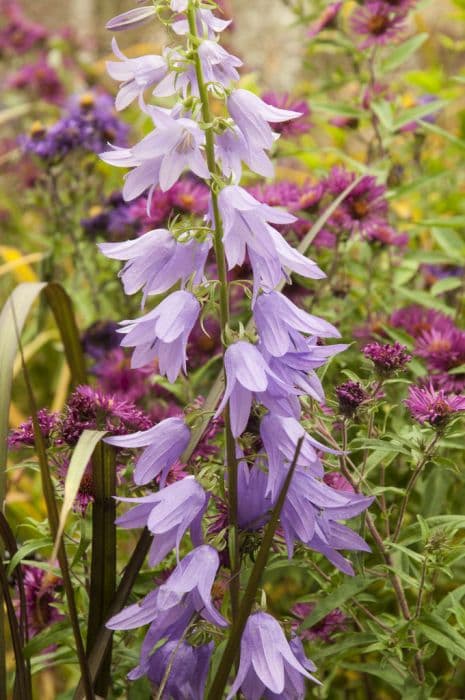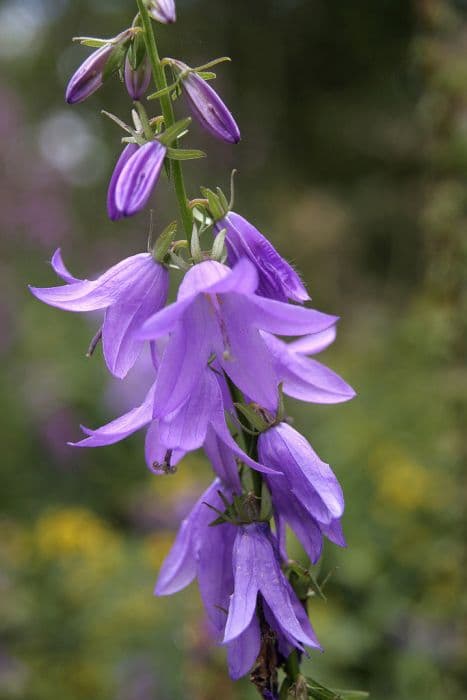Rock Bellflower Edraianthus pumilio

ABOUT
Edraianthus pumilio, commonly referred to as the rock bellflower, is a charming, tufted perennial plant that boasts a compact and dense habit, forming cushions or small mounds of narrow, grass-like leaves that are a deep green in color. This foliage provides a lush backdrop for the striking bell-shaped flowers that emerge in late spring or early summer. The blossoms are borne on short stalks and exhibit a vivid blue to purple hue, with five petals that open widely from a tubular base. The flowers' color and shape contrast beautifully with the foliage, making the rock bellflower a delightful addition to any garden setting where it can be admired up close. The plant's overall appearance exudes a delicate and whimsical charm, inviting onlookers to take a closer look at its intricate details. Its ability to thrive in rock gardens and alpine settings further underscores its allure, drawing in enthusiasts of unique and hardy botanical specimens.
About this plant
 Names
NamesFamily
Campanulaceae
Synonyms
Rock Bellflower, Balkan Edraianthus, Cushion Bellflower
Common names
Campanula pumila, Wahlenbergia pumilio, Edraianthus dalmaticus, Edraianthus tenuifolius subsp. pumilio.
 Toxicity
ToxicityTo humans
Edraianthus pumilio, commonly known as the rock bellflower, is not widely reported to be toxic to humans. There is no significant information suggesting that this plant is poisonous, and it does not appear on commonly referenced lists of toxic plants. However, as with any plant, individual allergic reactions or sensitivities can occur, and it's generally advisable to avoid ingesting plants that are not known to be edible.
To pets
Rock bellflower, or Edraianthus pumilio, does not have a reputation for being toxic to pets. There is no widespread evidence of its toxicity in animals such as dogs and cats. As with humans, there is always a risk of individual allergic reactions or gastrointestinal upset if pets consume plant material they are not accustomed to. If a pet ingests part of this plant and shows signs of distress, it is recommended to seek advice from a veterinarian.
 Characteristics
CharacteristicsLife cycle
Perennials
Foliage type
Evergreen
Color of leaves
Green
Flower color
Blue
Height
0.5 feet (15 cm)
Spread
0.5 feet (15 cm)
Plant type
Herb
Hardiness zones
4
Native area
Balkans
Benefits
 General Benefits
General Benefits- Low Maintenance: Edraianthus pumilio, commonly known as rock bellflower, is a hardy perennial that requires minimal care once established, making it ideal for gardeners seeking low-maintenance plants.
- Drought Tolerance: Rock bellflower is well-adapted to survive periods of drought, which can be very beneficial in arid regions or during water restrictions.
- Rockery Enhancement: This plant is particularly suited for rock gardens, providing texture and color with its grassy foliage and blue to violet bell-shaped flowers.
- Attracts Pollinators: The flowers of rock bellflower attract bees and butterflies, which are crucial for pollination and the overall health of the garden ecosystem.
- Ground Cover: With its compact growth habit, rock bellflower can serve as an effective ground cover, helping to reduce soil erosion and suppress weeds.
- Ornamental Value: The vibrant blooms and mounding form of rock bellflower add ornamental value to gardens and landscapes, enhancing aesthetic appeal.
- Alpine Gardens: Rock bellflower is well-suited for alpine gardens, where it can thrive in the well-draining soil and cooler conditions typical of high-altitude environments.
- Container Gardening: It is adaptable to container gardening, allowing those with limited space to enjoy its beauty on patios, balconies, or terraces.
- Border Plant: Rock bellflower works well as a border plant, delineating garden spaces and providing a burst of color along edges and pathways.
- Cold Hardy: This plant is capable of withstanding cold temperatures, making it suitable for gardens in cooler climates.
 Medical Properties
Medical PropertiesThis plant is not used for medical purposes.
 Air-purifying Qualities
Air-purifying QualitiesThis plant is not specifically known for air purifying qualities.
 Other Uses
Other Uses- Edraianthus pumilio (Grassy Bells) can be dried and used in floral arrangements, adding a unique texture and splash of color to the composition.
- Grassy Bells are utilized in rock gardens for their ability to grow in crevices, simulating natural alpine environments.
- Due to their compact and low-growing nature, Grassy Bells make excellent ground cover plants, helping prevent soil erosion on slopes.
- Edraianthus pumilio can be used to create living borders along walkways, providing a natural delineation with minimal upkeep.
- Grassy Bells' bright blooms are attractive to butterflies and bees, making them a beneficial addition to pollinator gardens.
- Photographers and artists may feature Grassy Bells in their work to capture the detailed structure and vibrant color of the plant.
- Grassy Bells works well in fairy and miniature gardens, contributing to the whimsical, small-scale landscapes.
- Educational use in botany classes to demonstrate plant adaptations in rough terrain like gravel beds and alpine conditions.
- Culinary artists may use the non-toxic flowers as a decorative and delicate garnish for dishes and desserts.
- In craft projects, Edraianthus pumilio can be pressed and included in hand-made paper to add texture and visual interest.
Interesting Facts
 Feng Shui
Feng ShuiThe plant Edraianthus pumilio is not used in Feng Shui practice.
 Zodiac Sign Compitability
Zodiac Sign CompitabilityThe plant Edraianthus pumilio is not used in astrology practice.
 Plant Symbolism
Plant Symbolism- Resilience: Edraianthus pumilio, also known as rock bellflower, often grows in rocky, mountainous areas, symbolizing its ability to thrive in challenging conditions and representing resilience in the face of adversity.
- Endurance: The rock bellflower's hardy nature speaks to enduring through hardships, much like it endures the harsh climates where it is native.
- Uniqueness: With its distinctive cushion-like shape and vibrant flowers, the rock bellflower symbolizes the beauty of being unique and standing out in one's environment.
 Water
WaterFor the Grassy Bells, it's important to allow the soil to dry out somewhat between waterings, as this plant prefers well-draining soil conditions. Typically, watering once a week is sufficient, but this may vary depending on climate and environmental conditions. When watering, aim to apply approximately one gallon of water for outdoor plants or about 8-12 ounces for smaller indoor pots, ensuring thorough soil saturation. During the winter months, reduce watering frequency to match the plant's reduced growth and evapotranspiration rates.
 Light
LightGrassy Bells thrive best in full sun to partial shade conditions. They should be placed in a location where they can receive at least six hours of sunlight daily. If grown indoors, a south-facing window or an area that gets bright, indirect light most of the day is ideal. Avoid deep shade as this can lead to weak growth and fewer blooms.
 Temperature
TemperatureGrassy Bells are comfortable in temperatures ranging from about 60 to 75 degrees Fahrenheit, which are their ideal growing conditions. These plants can tolerate a minimum temperature down to 30 degrees Fahrenheit, but frost can be harmful so they should be protected or moved indoors in colder climates. Maximum temperature tolerance is around 80 degrees Fahrenheit, above which the plant may experience stress.
 Pruning
PruningPruning of Grassy Bells is done mainly to remove spent flower stems and to encourage bushiness. Light pruning can be performed in early spring or after the main flowering period to help maintain shape and vigor. Pruning is not often required, but doing so after the first flush of blooms can occasionally stimulate a second bloom period.
 Cleaning
CleaningAs needed
 Soil
SoilEdraianthus pumilio, commonly known as Rock Bellflower, thrives in a well-draining gritty mix, such as a blend of loam, sand, and peat, with a slightly acidic to neutral pH of 6.0 to 7.0. A mix designed for alpines or succulents can work well.
 Repotting
RepottingRock Bellflower should be repotted every two to three years or once it has outgrown its current pot to refresh the soil and encourage healthy growth.
 Humidity & Misting
Humidity & MistingRock Bellflower does well in moderate humidity levels and does not require high humidity, making it suitable for average home environments.
 Suitable locations
Suitable locationsIndoor
Place Rock Bellflower near a sunny window and ensure good airflow.
Outdoor
Plant Rock Bellflower in rock gardens or crevices with full sun.
Hardiness zone
Rock Bellflower is suitable for zones 4-8 USDA.
 Life cycle
Life cycleEdraianthus pumilio, commonly known as rock bellflower, begins its life cycle as a seed that requires a period of cold stratification to break dormancy. After germination in spring, the seedling grows into a small, mat-forming perennial with linear to lanceolate leaves, establishing its root system. During late spring and summer, rock bellflower produces its distinctive bell-shaped blue to violet flowers atop slender, erect stems. Following pollination, often by insects, these flowers give way to seed capsules, completing the reproductive stage. Seeds disperse in late summer to autumn, allowing for a new generation to begin the cycle. Throughout the growing season, rock bellflower may also spread vegetatively through its creeping stems, adding to its clumps and expanding its presence in rocky, montane habitats.
 Propogation
PropogationPropogation time
Spring to early summer
Propogation: The most popular method of propagating Edraianthus pumilio, commonly known as rock bellflower, involves sowing seeds. The best time for propagating this perennial by seeds is late winter to early spring. Seeds should be scattered on the surface of a well-draining seed starting mix and lightly covered with soil. The container with seeds should be placed in a bright, but not directly sunlit location, and should be kept moist until germination, which usually takes several weeks. Once seedlings grow large enough they can be transplanted into individual pots or directly into the garden at a spacing of approximately 6 inches (about 15 cm) apart to give them room to grow.




![Trailing lobelia [Techno Heat Trailing Light Blue Improved]](/_next/image?url=https%3A%2F%2Fplants-admin.emdemapps.com%2Fimages%2Fplants%2F%2Fimages%2F604b65196de60.png&w=640&q=75)




